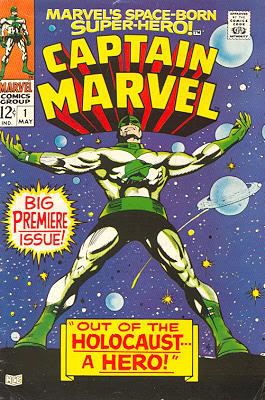
art by Gene Colan
Sales of Mar-vell's title were poor and it was canceled after issue #21. In the early 70s Mar-vell's title resumed and the character was altered by writer Roy Thomas. Mar-vell finds himself trapped within the Negative Zone but he develops a cross-dimensional telepathic bond with former Hulk and Captain America sidekick Rick Jones and the two are able to switch dimensional position using a pair of Kree designed "nega-bands". Thomas has said this was done to echo the boy/man shift of the Fawcett Captain Marvel.
Not long after writer/illustrator Jim Starlin took over the title and made further alterations, most notable being his assignment by the omnipotent being Eon to be the "Protector of the Universe". With this role came a new power, a Zen-like state of connection with all things termed "Cosmic Awareness". Eon, it is worth noting, is dedicated to protection of the Celestial Axis.
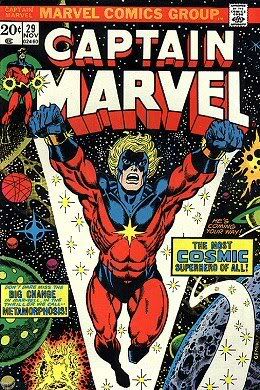
art by Jim Starlin
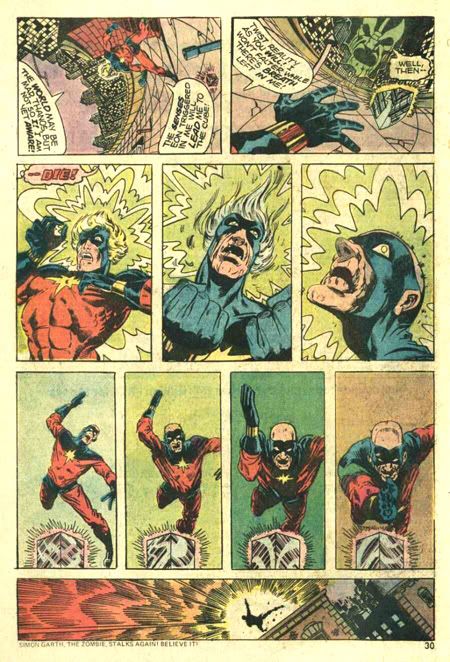
Cap destroys the Cosmic Cube, art by Jim Starlin.
Mar-vell's most notable opponent was the Mad Titan Thanos. For many years Mar-vell had the rare distinction of being one of the few super heroes to die and stay dead (a facet shared with Jean Grey, however, both characters have subsequently returned to the living). Mar-vell's case was particularly atypical as his death came from incurable cancer he developed from exposure to a nerve gas during a super battle years earlier. This was depicted by Starlin in the 1982 "Marvel Graphic Novel" #1. Note the Pieta positioning of Death and Mar-vell on the cover of this barely veiled astro/religious comic book allegory.
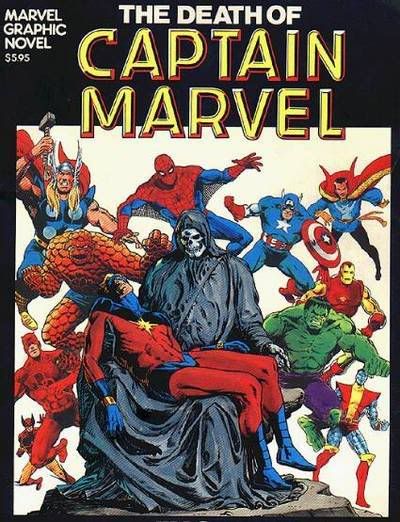
art by Jim Starlin
With the publication of this story, with this cover image, in this adult-oriented format, there could be no doubt that American comic books had recently entered the Bronze Age.
As we all know it is common for popular male super heroes to have a female counterpart introduced at some point in their adventures. Superman has Supergirl, Spider-Man has Spider-Woman, and the Shazam Captain Marvel has Mary Marvel, who is in fact the first of the female variants. Captain Mar-vell is no exception to this pattern. In 1977 a cast member from the Marvel "Captain Marvel" title gained super powers and a series all her own and in time she came to be even more important and iconic then her male character she was based upon. She's Carol Danvers, Ms. Marvel.

art by John Romita
Carol is exposed to the alien radiation of a Kree "Psyche-Magnitron" which causes her DNA to intermix with Mar-vell's, giving her super strength and durability, the ability to fly and a Spider-Sense-like "Seventh Sense" (skipping over a sixth for some reason). Note how in the second and more famous costume of Ms. Marvel we again see a stylized lightning bolt of enlightenment as an emblem.
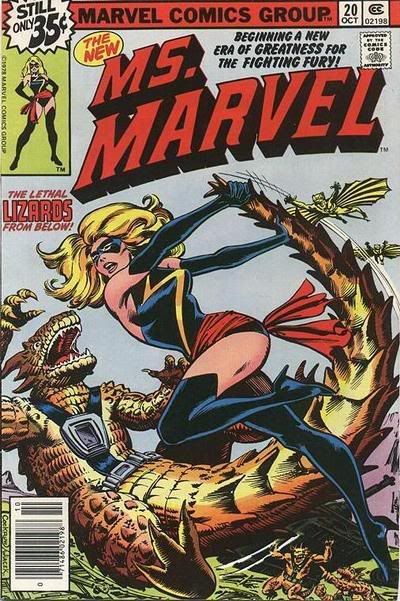
art by Dave Cockrum
Besides her solo adventures, Ms. Marvel was a member of "The Avengers". In issue #200 of that title, one of Marvel's strangest stories (no small feat), she finds herself pregnant from what seems to be an immaculate conception. The pregnancy progresses at a greatly accelerated rate and she soon gives painless birth to a son.

Art by George Perez
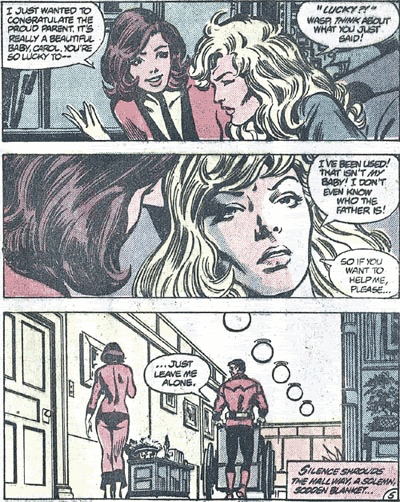
Art by George Perez
The son, Marcus, grows quickly to adulthood and informs Ms. Marvel that he is from the dimension Limbo from where he had observed and fallen in love with her. He confesses that he kidnapped, brainwashed, seduced and impregnated her and returned her to Earth with no memory of the event, and in the processes served the role of being his own father.
In a confusing time-knot only super hero comic books could produce, Marcus, it turns out, is the son of the time traveling Avengers villain Immortus, who was the future version of the Avengers time traveling villain Kang the Conqueror, who was originally seen in comics in his guise as the false Pharaoh Rama-Tut in "Fantastic Four" #19. The problem was, Immortus got it in his head at one point to kill Kang, which had the effect of removing Immortus from existence (but not apparently enough-so to stop him from doing it somehow). Immortus lived in timeless Limbo and at a "moment" previous to his self-erasing he had kidnapped a woman from Earth, brainwashed her and impregnated her with Marcus. In proper comic book fashion she was a near duplicate of Carol Danvers.
After his father's discorporation Marcus concocts his scheme to get from Limbo to Earth. He chooses Ms. Marvel due to her Kree-enhanced physiology and her resemblance to his mother.
Strangely after this revelation Ms. Marvel agrees to return to Limbo with Marcus (later explained as her still being under his mind-control). Worse is that her teammates on the Avengers all seem to think it swell and wish the happy couple well as they head off to honeymoon in Limbo. It's an unintentionally disturbing comic book story that makes obvious reference to Greek mythological modes like the tragedy of Oedipus. But at least one lucky reader won a Toys-R-Us Shopping Spree.
This Rape of Ms. Marvel was highly controversial and didn't sit well with many, including X-Men writer Chris Claremont, who had also written many issues of the Ms. Marvel series. He returned the character to Earth in 1981's "Avengers Annual" #10. But back on Earth Carol Danvers is not Ms. Marvel for long as she loses her super abilities and memories to the mutant power stealing Rogue of the second Brotherhood of Evil Mutants. This leads to the now powerless Carol Danvers spending some time in the early 80s as a supporting cast member in the X-Men comics, as the telepathic Professor Xavier helps her reclaim her stolen psyche.
To make her matters worse, while with the X-Men Carol is abducted by and experimented on by the very "Alien"-like extraterrestrial race the Brood. This results in her gaining new, cosmic level super powers, due to her ability to tap into the energies of a White Hole. She renames herself Binary and joins up with the space-faring buccaneers called The Starjammers adventuring in the deep space of the Marvel Universe, and seldom appearing on the printed page.
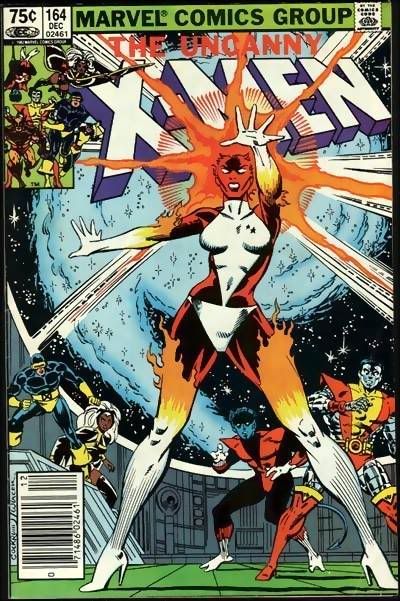
art by Dave Cockrum
Shortly afterwards the X-Men get to make good use of Carol Danver's former Kree-spawned powers when Rogue switches sides and becomes a member of the team. Like Carol, Rogue needs Xavier's help to balance out her now warring double psyche.
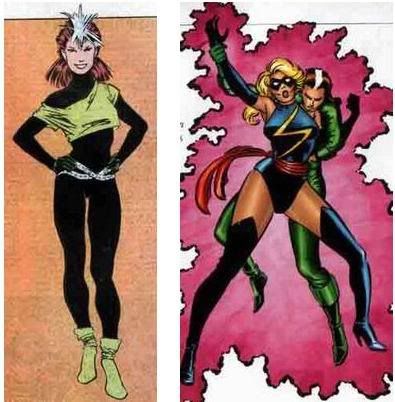
Art by John Romita, Jr.
This is an aspect of the Rogue character that is completely absent in the X-Men movies, for simplicity's sake I'm sure, but it's a shame because it's an interesting facet of Rogue's character, and one present since her initial appearance in "Avengers Annual" #10. Rogue automatically absorbs the powers and memories of anyone she makes skin to skin contact with. During her assault on Ms. Marvel she maintains contact for too long and the transference becomes permanent. Rogue brings the X-Men not only her ability to duplicate powers but also Ms. Marvel's super strength, invulnerability and flight, powers that she utilizes far more frequently in the course of the X-Men's adventures. Since Rogue started her career as a mutant terrorist, the protoge and foster child of Mystique, it is possible but never clearly stated that her change in morality is due to the heroic inclinations of Carol Danvers and not those of Rogue herself.
This was the status quo for many years before Marvel revived the Avengers title in 1998 and writer Kurt Busiek and illustrator George Perez decided to return Carol Danvers to the team. Her connection to the White Hole faded and her powers reverted to levels comparable to her Ms. Marvel identity. She returned to her traditional blue costume and operated under the name Warbird, eventually returning to the identity of Ms. Marvel. This identity switch followed Marvel's fairly recent alternate reality storyline "The House of M", in which Carol Danvers operated under the identity of Captain Marvel.
But Carol was not the first female super hero to go by the name Captain Marvel. After the death of Mar-vell, Marvel Comics introduced Monica Rambeau in the 1982 "Amazing Spider-Man Annual" #16. This character, unrelated to the other Marvel Marvels, was bombarded with extra-dimensional energies by an experimental device and gained the ability to transform into living light. She served as an Avenger and eventually changed her name to Photon.
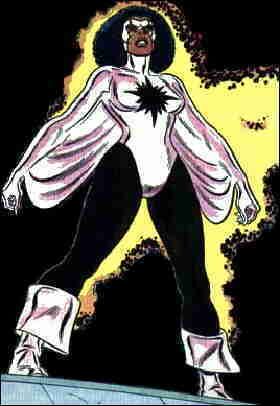
Art by John Buscema
Confusing the matter, however, is the character of Genis-Vell, the son of Captain Mar-vell, who also went by both the names Captain Marvel and Photon.
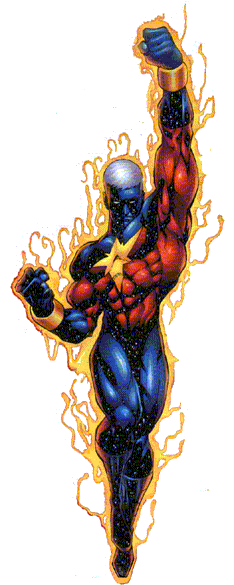
Art by Chris Cross
There was also another Ms. Marvel for a short time in the 80s, the character Sharon Ventura, a super strong wrestler and girlfriend of the Thing. At one point Sharon was bombarded by cosmic radiation and transformed into a female Thing, as Ben Grimm might say, a revoltin' development.

As Ms. Marvel, art by Ron Wilson

As She-Thing, art by Sal Buscema(?)
And this is far from the only reiteration of the Marvel character names in Marvel Comics. There was a telekinetic character named Vance Astrovik, an alternate version of Vance Astro of the future based Guadians of the Galaxy. While serving with the teen-aged group The New Warriors, Astrovik was called Marvel Boy. Later, as an Avenger, he was called Justice.
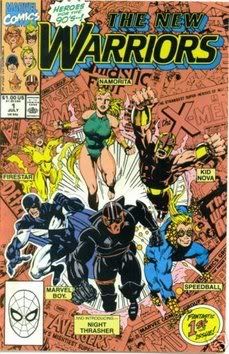
Art by Mark Bagley
Then in 2000 yet another Marvel Boy was introduced by writer Grant Morrison and illustrator J.G.Jones. This time the character is once again of Kree origin, Noh-Varr, the sole survivor of a Kree alternate dimensional cruiser called "The Marvel".
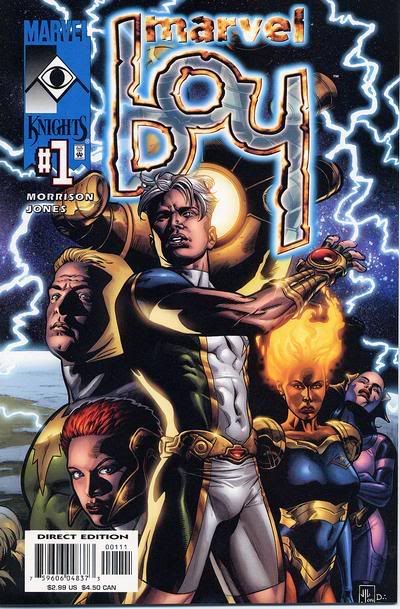
Art by J.G.Jones. Gotta love that logo.
Morrison has a true gift for enhancing the inherent surrealism of super hero comic books to a level of Baroque beauty. His "Marvel Boy" comes from and lands in alternate Marvel realities then the one presented in the bulk of the Marvel titles. He's presented somewhere between a blood thirsty super terrorist and a inter-celestial messiah in a corrupt reality of mindless devotion to synthetic corporate interests masquerading as government and society. Marvel Boy wishes to liberate this Earth and bring it to what he considers to be the Utopian state of Kree culture.
The Kree are served by/ruled by/worshipful of an ancient, telepathic living computer called the Supreme Intelligence. Created to help the Kree generate a Cosmic Cube, the Supreme Intelligence is an amalgamation of the minds of the Kree's greatest thinkers, politicians, scientists and philosophers. Morrison depicts Marvel Boy as the protagonist, however, near the end of the series another character aptly describes the Kree society as a Zen-Fascist state.
The Marvel Boy series, like Morrison's work on pre-established characters and titles like "JLA", "Animal Man", "The Doom Patrol" , the "New X-Men", "Arkham Asylum" and "Seven Soldiers" takes readers to places they never expected or experienced with these familiar figures. It's magic, he's a magician and the spells he casts are woven out of the pure esoteric symbolism inherent in the genre.
The last of the Marvels I wish to discuss as my chosen culmination of this labyrinth of children's entertainment is the ground breaking 1994 limited series simply titled "Marvels". The product of the team of writer Kurt Buseik and painer/illustrator Alex Ross, "Marvels" perhaps more directly then any of the other titles I've discussed, exercises the term as way of describing miraculous, symbolic, religious mythology on a scale from the cosmic to the deeply personal.
The Marvels of the title is the emergence of these various fantastic beings waging incomprehensible secret wars across the Universe (but mostly in Manhattan). The story is told across time from the 1940s to the early 70s from the vantage point of an innocent bystander, a figure oft overlooked and overshadowed on the comic book page. In "Marvels" this role is filled by photographer Phil Sheldon. Told in four issues (with a fifth with supportive material), the story covertly chronicles the Great Ages of comic books through typifying events from the crux points of Marvel history. All art that follows is by Alex Ross.
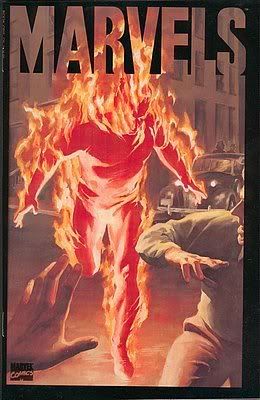
Issue one begins with the birth of the Marvels as heralded by Carl Burgos' Promethean Human Torch. Special emphasis is placed on the monumental rivalry between the Torch and Bill "William Blake" Everett's Hermetic Atlantean Sub-Mariner. Ross' treatment is suffused with the Classical elements of this ancient conflict. It is interesting that while observing this battle, observer Phil Sheldon loses his left eye when he's struck by a chunk of flying debris.
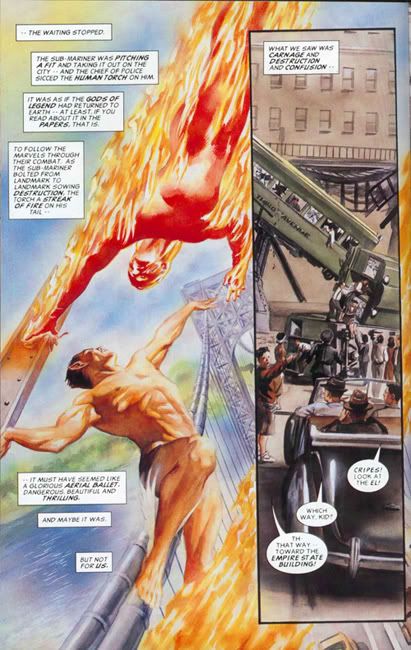
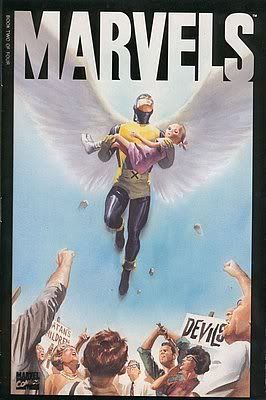
Issue two moves from the Golden Age to shortly after the advent of the Silver. The story focuses on the emergence of the Mutant population, feared and loathed by the majority of the normal population. This is even the case with heroic, but mysterious figures like the X-Men. The Mutant hating sentiment culminates with the creation of the artificially intelligent Mutant hunting Sentinel robots, which almost immediately go rogue. As they attempt to secure complete control for the purpose of protecting the populace, New York City erupts in anti-Mutant hysteric riots.
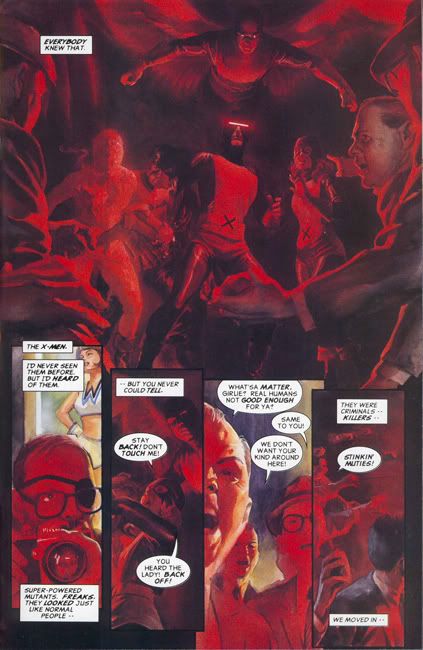
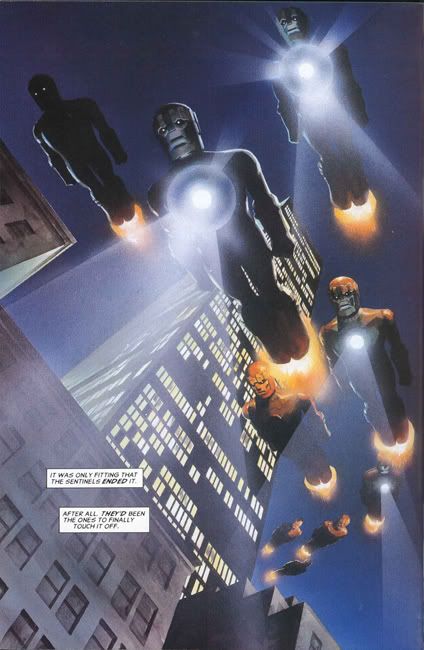
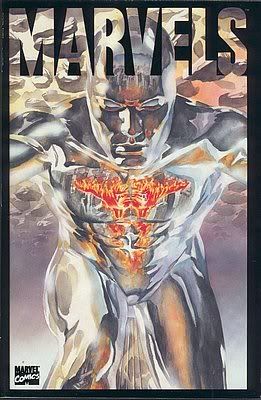
The third issue takes place a few years later around the monumental, near-Armageddon Coming of Galactus. Galactus, the world devourer, was conceived by Jack Kirby as God. Kirby's God, however, is a Demiurge, not the Creator. He is Saturn. This is clear. Saturn swallows his children, the planes/planers/planets.
Galactus is heralded by the Hermetic Silver Surfer, in his typifying role as psychopomp, in this case leading the whole of the world to the afterlife. This story was part of the plot in the recent "Fantastic Four: Rise of the Silver Surfer", which was pretty interesting. They did a great job with the difficult character of the Surfer, and it was excellent that he was voiced by Lawrence "Morpheus" Fishburne. Visually the movie makers opted to make Galactus a sentient black hole, or nebula or something, but nothing they did matched the sheer beauty of Ross' faithful enhancements of Kirby's energetic original images.

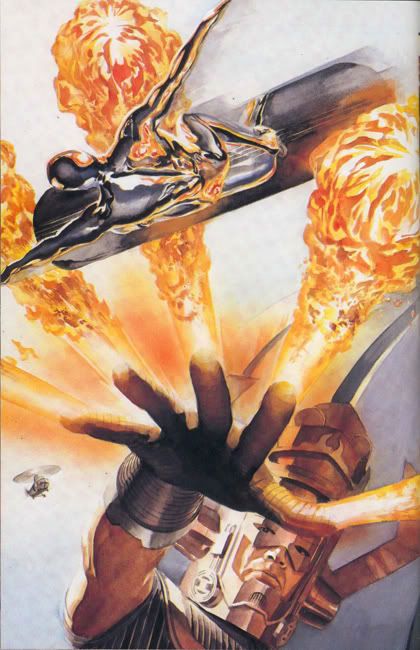
What was really wrong in the movie, however, was how Galactus was defeated (that and their fricked-up Dr.Doom). The Silver Surfer can not beat Galactus, it's a ridiculous concept. Is it too much to ask for an Ultimate Nullifier to be worked in? The Torch in Taa II could have been the trippiest Cosmic movie sequence since "2001", but I digress.
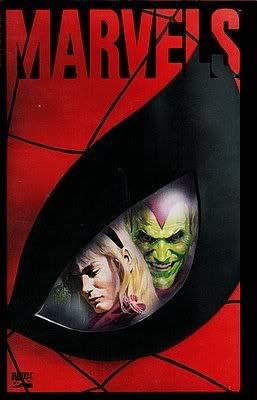
The final issue of "Marvels" focuses on a very small event when compared to the arrival of Galactus, but one that is equally mythic in its way, and clearly indicative of the shift to the Bronze from the Silver Age. Spider-Man's long-running animosity with the Green Goblin culminates in 1973 with the Goblin's kidnapping of Peter Parker's girlfriend Gwen Stacey. The Goblin drops Gwen from the top of a bridge before Spider-Man can rescue her. Spider-Man manages to snag her with a web but her neck snaps during the fall. This was a monumental moment in Peter Parker's life and for his readers, with a pathos the movie makers completely managed to miss for some reason. This was the death of innocence, the fall of the Maiden, the harsh reality that love itself is materially fragile despite even super human efforts. This was the sad and quiet beginning of the shift from the Silver to the Bronze Age.
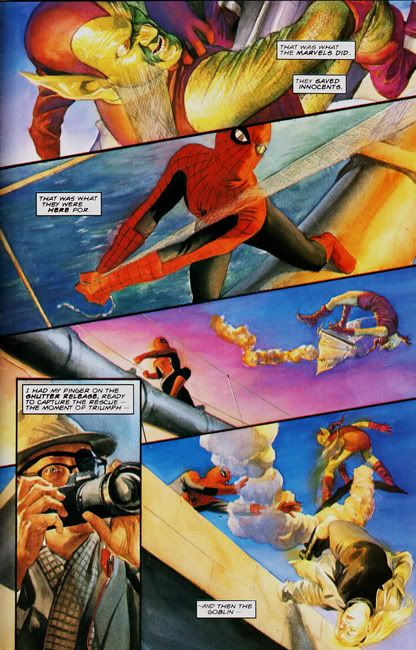
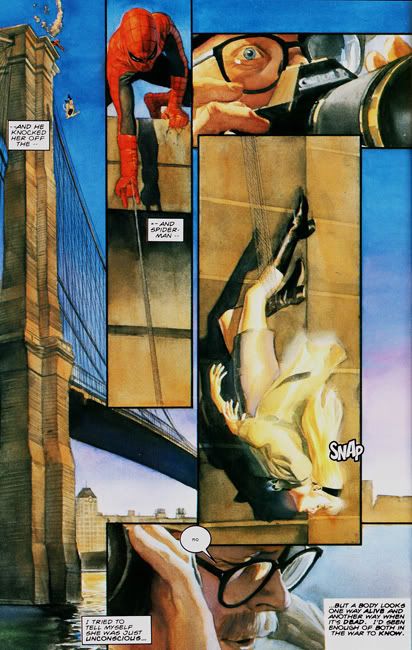
Ross tells the story of the Iron Age with a different pantheon of figures in DC's "Kingdom Come", which we will certainly dissect with pleasure at a future point.
Part of the power of the story told in "Marvels" is that the characters exist in the time when the stories first appeared, rather then on a floating timeline utilized to maintain "continuity". This rare quality is key to the underlying meaning of this largest and most abstract handling of the term Marvels. The Marvels in this case are the Great Ages themselves. This is the allegory of the transmutation through time on a cosmic level, told as always in the form of argotic symbols.